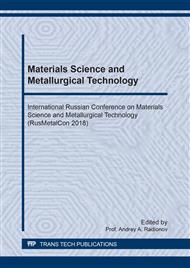[1]
L.V. Radionova, A.A. Radionov, Modern state and development prospects of steel wire drawing production, Machine-building: web electronic scientific magazine, 1 (2013) 3-11.
Google Scholar
[2]
L.V. Radionova, V.A. Kharitonov, Designing source saving technologies of high-tension carbon steel production on the basis of simulation, Magnitogorsk: HVS MSTU,, (2008).
Google Scholar
[3]
L.V. Radionova, V.A. Kharitonov, S.G. Posadsky, Analytical study of temperature mode of carbon wire drawing of multiple machines, Dep. in AUISTI. 14.07.2000. No.1936-V00.
Google Scholar
[4]
G.L. Kolmogorov, V.B. Filippov, E.V. Kuznetsova, About strain rate while drawing, Bulletin of higher education institutions. Ferrous Metallurgy. 8 (2005) 17-19.
Google Scholar
[5]
L.V. Radionova, A.A. Radionov and others, Software for automated calculation of source saving routes and hardening while carbon wire drawing, Materials science and thermal metal treatment: Internat. col. scient. works.; edit. by A.N. Yemelyushina. Magnitogorsk, MSTU, 2004. Ed. 2.104-110.
Google Scholar
[6]
V.A. Kharitonov, L.V. Radionova, E.V. Safonov, Simulating temperature mode of carbon wire drawing of multiple machines, Simulation and development of technological processes: Col. scient. works, Magnitogorsk: MSTU, (2004) 134-141.
Google Scholar
[7]
S.V. Avseykov, U.L. Bobarikin, Influence of deformation speed on plastic deformation resistance of carbon brass plated wire while fine drawing, Bulletin of SUHT named after P.O. Sukhoy. 3 (2013) 25-31.
Google Scholar
[8]
M.N. Vereschagin, U.L. Bobarikin and others, Influence of drawing speed on temperature and stress strain behaviour in high-carbon steel wire, Steel. 12 (2007) 53-58.
Google Scholar
[9]
A.A. Radionov, L.V. Radionova, Technology production of high-strength wire with high plastic properties, Sworld collection of scientific works based on materials of interational scientific practical conference. 6(1) (2013) 12-16.
Google Scholar
[10]
Sy-Wei Lo, Yuung-Hwa Lu, Wire drawing dies with prescribed variations of strain rate, Journal of materials processing technology, 123 (2002) 212-218.
DOI: 10.1016/s0924-0136(02)00033-x
Google Scholar
[11]
C.J. Luis, J. Leon, R. Luri, Comparison between finite element method and analytical methods for studying wire drawing processes, Journal of materials processing technology. 164-165 (2005) 1218-1225.
DOI: 10.1016/j.jmatprotec.2005.02.138
Google Scholar
[12]
E.M. Rubio, A.M. Camacho, L. Sevilla, M.A. Sebastian, Calculation of the forward tension in drawing processes, Journal of Materials Processing Technology, 162-163 (2005) 551-557.
DOI: 10.1016/j.jmatprotec.2005.02.122
Google Scholar
[13]
Z. Muskalski, S. Wiewiórowska, The theoretical analysis of wire drawing process or hydrodynamic friction conditions, Metallurgical and mining industry. 3(7) (2011) 74-78.
Google Scholar
[14]
R. Fabík, P. Halfarová, Impact of drawing process parameters on uniformity of strain in spring wire, Metal. 2011, No.18-20.
Google Scholar
[15]
L.V. Radionova, V.A. Kharitonov, E.V. Safonov, Reducing deformation inhomogeneity by wire section while drawing in monolith wire-die, Dep. in AUISTI. 22.08.2001. 1893-V2001.
Google Scholar
[16]
L.V. Radionova, V.A. Ivanov, V.S. Shatalov, Study of influence of operating angle value of monolith wire-die on stress strain behaviour of wire in deformation area, Machine-building: web electronic scientific magazine, 2 (2014) 21-25.
Google Scholar
[17]
Patent of Russia No.2183523, Method of producing of high-carbon wire, (2001).
Google Scholar
[18]
L.V. Radionova, V.A. Kharitonov, V.I. Zyuzin, L.D Rol'shchikov, New technological lubricants for steel wire drawing, Steel in Translation. 12 (2001) 49-50.
Google Scholar


